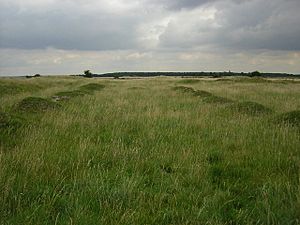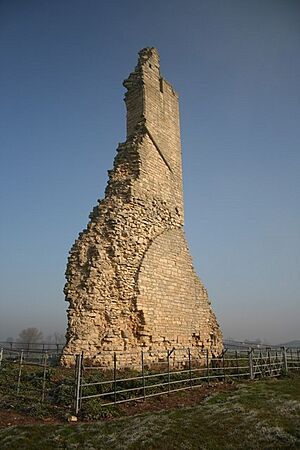List of monastic houses in Lincolnshire facts for kids
Monastic houses were special places where groups of people, like monks or nuns, lived together under religious rules. They dedicated their lives to prayer, work, and study. In Lincolnshire, England, there were many such houses, including abbeys, priories, and friaries. These places played a big role in society, offering education, healthcare, and shelter, especially during the Middle Ages.
This article explores some of the most important monastic sites in Lincolnshire. It explains who lived there, when they were founded, and what happened to them. Many of these ancient buildings are now ruins, while others have become parts of modern churches or homes.
Alien houses are included, as are smaller establishments such as cells and notable monastic granges (particularly those with resident monks), and also camerae of the military orders of monks (Knights Templars and Knights Hospitaller). Monastic hospitals are included where they had the status or function of an abbey, priory, friary or preceptor/commandery.
- Abbreviations and key
| Symbol | Status |
|---|---|
| None | Ruins |
| * | Current monastic function |
| + | Current non-monastic ecclesiastic function (including remains incorporated into later structure) |
| ^ | Current non-ecclesiastic function (including remains incorporated into later structure) or redundant intact structure |
| $ | Remains limited to earthworks etc. |
| # | No identifiable trace of the monastic foundation remains |
| ~ | Exact site of monastic foundation unknown |
| ≈ | Identification ambiguous or confused |
Locations with names in italics indicate possible duplication (misidentification with another location) or non-existent foundations (either erroneous reference or proposed foundation never implemented) or ecclesiastical establishments with a monastic name but lacking actual monastic connection.
| EH | English Heritage |
| LT | Landmark Trust |
| NT | National Trust |
Contents
- Understanding Monastic Houses
- Notable Monastic Houses in Lincolnshire
- Bardney Abbey: A Story of Destruction and Rebirth
- Alvingham Priory: A Double House Community
- Aslackby Preceptory: Home of the Knights Templar
- Axholme Priory: A Quiet Carthusian Life
- Barlings Abbey: A Premonstratensian Community
- Crowland Abbey: A Long History of Faith
- Deeping St James Priory: A Dependent Cell
- Eagle Preceptory: Another Templar Stronghold
- Kirkstead Abbey: A Cistercian Foundation
- Monastic Houses in Major Towns
- Images for kids
- See also
Understanding Monastic Houses
What is a Monastic House?
A monastic house is a building or group of buildings where monks or nuns live together. They follow a specific set of religious rules. These communities were very important in medieval times. They were centers of learning, prayer, and charity.
Different Types of Monastic Houses
There were several types of monastic houses in England:
- Abbeys: These were large, independent communities led by an Abbot (for monks) or an Abbess (for nuns).
- Priories: Smaller than abbeys, priories could be independent or dependent on a larger abbey. They were led by a Prior or Prioress.
- Friaries: These were homes for friars, who were different from monks. Friars lived among people in towns and cities, often begging for food and helping the poor.
- Preceptories: These were houses for military religious orders, like the Knights Templar or Knights Hospitaller. They managed lands and recruited members.
- Nunnery: A general term for a monastic house for nuns.
- Cell: A very small monastic house, usually dependent on a larger abbey.
- Alien House: This term means the monastic house was controlled by a larger monastery in another country, usually France.
Why were they "Dissolved"?
The term "dissolved" means that these monastic houses were officially closed down. This happened mostly during the reign of Henry VIII of England in the 1530s. The King wanted to take control of their wealth and lands. Many buildings were destroyed, while others were sold off.
Notable Monastic Houses in Lincolnshire
Lincolnshire had many monastic houses. Here are some interesting examples:
Bardney Abbey: A Story of Destruction and Rebirth
- Saxon Monastery: The first monastery at Bardney was founded around 697 by King Æthelred of Mercia. He even became a monk and abbot there!
- Viking Raids: Sadly, this early monastery was destroyed by Viking raiders in 870.
- Benedictine Abbey: It was rebuilt as a Benedictine priory in 1087. Later, it became a full abbey in 1115.
- Dissolution: Bardney Abbey was dissolved in 1538. Its lands were given to Sir Robert Tirwhit. Today, you can visit its ruins.
Alvingham Priory: A Double House Community
- Gilbertine Order: This priory was unique because it was a "double house." This meant both Gilbertine Canons (monks) and Canonesses (nuns) lived there.
- Foundation: It was founded between 1148 and 1154.
- Dissolution: Alvingham Priory was dissolved in 1538. Some parts of it are still used as a church today.
Aslackby Preceptory: Home of the Knights Templar
- Knights Templar: This was a preceptory, a base for the Knights Templar. They were a military religious order, famous for protecting pilgrims. It was founded around 1164.
- Knights Hospitaller: After the Templars were dissolved, the preceptory was transferred to the Knights Hospitaller in the early 1300s.
- Modern Remains: Today, parts of the old preceptory are built into an 18th-century farmhouse.
Axholme Priory: A Quiet Carthusian Life
- Carthusian Monks: This priory housed Carthusian monks. They lived a very strict and quiet life, often in separate cells.
- Foundation: It was founded between 1395 and 1396 by Thomas Mowbray.
- Conversion: After its dissolution in 1538, the priory was turned into a manor house.
Barlings Abbey: A Premonstratensian Community
- Premonstratensian Canons: This abbey housed Premonstratensian canons, who were a type of religious order.
- Foundation: It was first founded in 1154-55. The community moved to a new site shortly after.
- Dissolution: Barlings Abbey was dissolved in 1537. Its stones were used to build other structures.
Crowland Abbey: A Long History of Faith
- Early Beginnings: A Saxon monastery existed here before 757. It was destroyed by Viking raiders in 870.
- Benedictine Restoration: The monastery was rebuilt and restored in 948.
- Dissolution and Survival: It was dissolved in 1539. The eastern part of the church was destroyed. However, a large part of the church is still used as a parish church today.
Deeping St James Priory: A Dependent Cell
- Benedictine Monks: This was a small priory, or "cell," dependent on Thorney Abbey in Cambridgeshire.
- Foundation: It was founded in 1139.
- Parochial Use: The priory church is still used as the Parish Church of St James today.
Eagle Preceptory: Another Templar Stronghold
- Knights Templar: This preceptory was founded before 1154 by Stephen of England. It served as a hospital and a base for the Templars.
- Knights Hospitaller: Like Aslackby, it was transferred to the Knights Hospitaller in 1312.
- Dissolution: It was dissolved in 1540.
Kirkstead Abbey: A Cistercian Foundation
- Cistercian Monks: Kirkstead Abbey was home to Cistercian monks, known for their simple and strict lives.
- Relocation: The community first settled at an earlier site in 1139. They moved to the current site in 1187.
- Dissolution: The abbey was dissolved in 1537. Its gatehouse chapel is still used as a local church.
Monastic Houses in Major Towns
Lincoln's Friaries: Urban Religious Life
The city of Lincoln was home to several friaries, different from abbeys and priories because friars lived and worked directly within towns.
- Austin Friars: Founded around 1269-70.
- Blackfriars (Dominican Friars): Founded before 1238.
- Greyfriars (Franciscan Friars): Founded around 1230. Part of their building now houses the City Museum.
- Whitefriars (Carmelite Friars): Founded before 1260.
- St Catherine's Priory: A Gilbertine priory founded after 1148.
- St Mary Magdalen Priory: A Benedictine cell, refounded around 1135. Its remains are now in a public park.
Boston's Friaries: A Hub of Religious Orders
The town of Boston was an important port and had several friaries:
- Boston Austin Friars: Founded in 1317-18.
- Boston Blackfriars: Founded before 1288. Parts of their buildings, like Shodfriars Hall, still exist.
- Boston Greyfriars: Founded before 1268.
- Boston Whitefriars: Founded in 1293, they moved to a new site in 1307.
- Boston Priory: A Benedictine priory founded around 1089. The famous Boston Stump was built on its site.
Grimsby's Monastic Past
Grimsby also had its share of monastic communities:
- Grimsby Abbey (Wellow Abbey): An Augustinian abbey founded around 1132.
- Grimsby Nunnery: An Augustinian nunnery founded before 1184.
- Grimsby Austin Friars: Founded in 1293.
- Grimsby Greyfriars: Likely founded before 1240.
Stamford's Rich Monastic History
Stamford was another important town with many religious houses:
- Stamford Austin Friars: Founded in 1343.
- Stamford Blackfriars: Founded before 1241.
- Stamford Friars of the Sack: Existed before 1274 but closed by 1300.
- Stamford Greyfriars: Founded before 1230.
- Stamford Whitefriars: Founded before 1268.
- Stamford — St Leonard's Priory: A Benedictine priory founded after 1083 on the site of an even older Saxon monastery.
Images for kids
See also


























